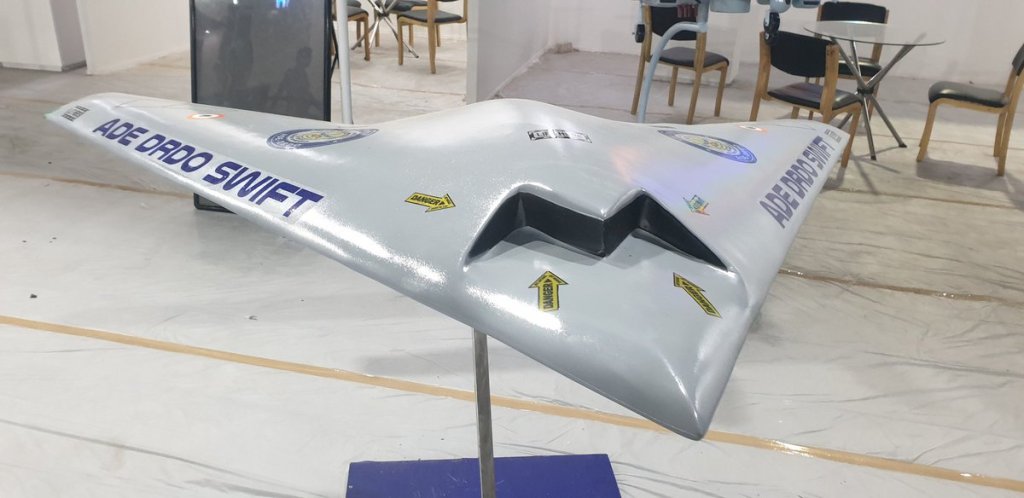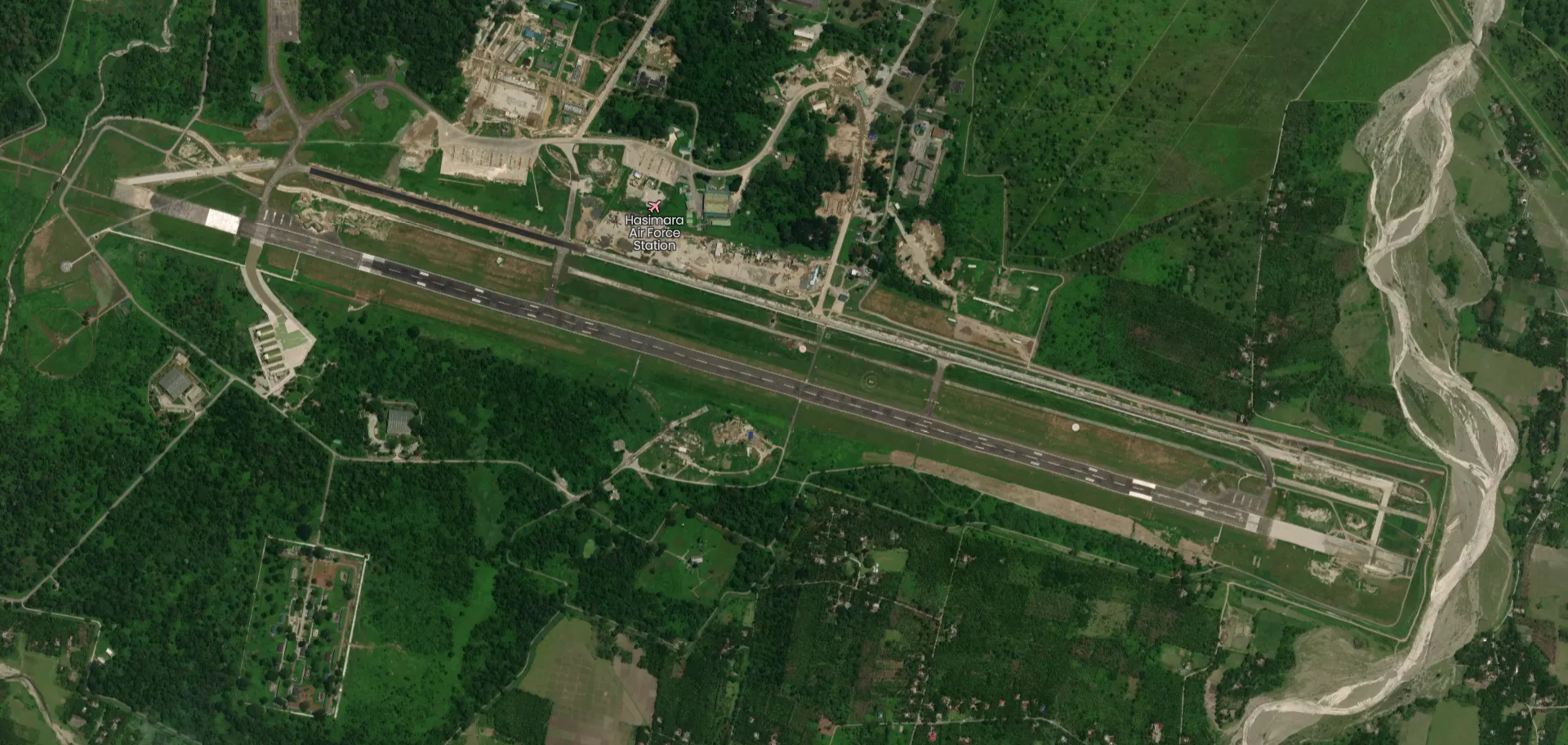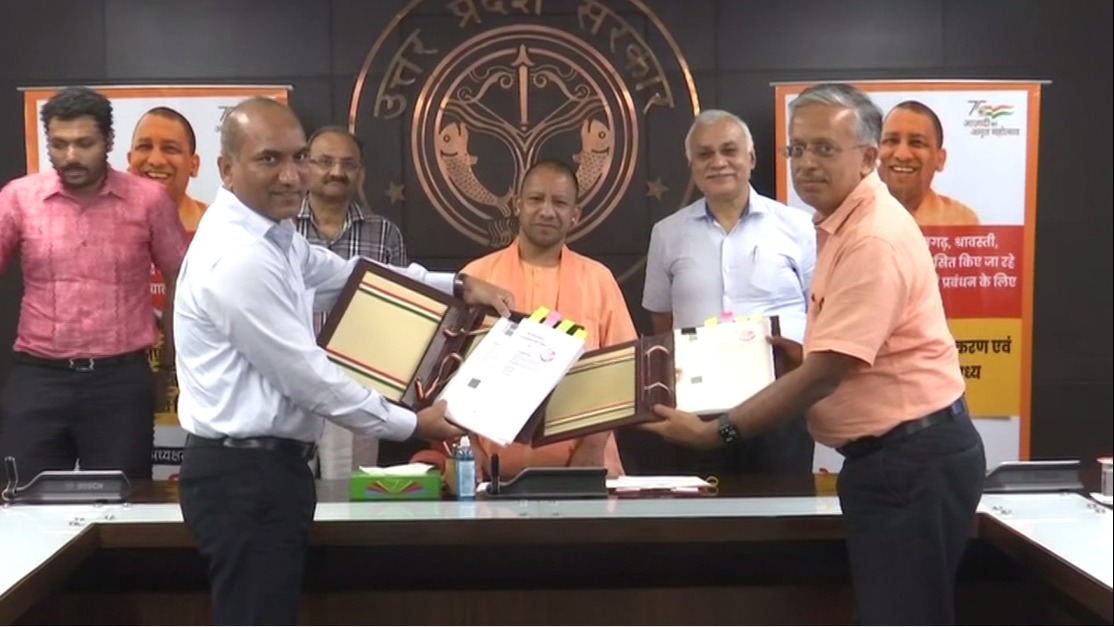In a first, India conducts the maiden flight of its "Stealth Wing Flying Testbed"
Prashant-prabhakar
02 Jul 2022

In what can be termed a major advancement toward India's plans to have a full-fledged stealth combat drone, the country successfully carried out the maiden flight of the Autonomous Flying Wing Technology Demonstrator from the Aeronautical Test Range at Chitradurga in Karnataka on Friday.
Defence View
The test demonstrator dubbed the "‘Stealth Wing Flying Testbed’ (SWiFT)", has an uncanny resemblance and looks like the mini version of a US B-2 stealth bomber with a similar “flying wing” configuration.
According to DRDO, the aircraft performed a perfect flight, including take-off, way-point navigation and a smooth touchdown while operating in a fully autonomous mode.
This flight marks a major milestone in terms of proving critical technologies towards the development of future unmanned aircraft and is a significant step towards self-reliance in such strategic defence technologiesDRDO
SWiFT-India’s secretive unmanned combat aerial vehicle (UCAV) programme
SWiFT UAV is a Technology Demonstrator and is a scaled-down version of Ghatak UCAV (Unmanned Combat Air Vehicle). The main intent of SWiFT UAV is to demonstrate and prove the stealth technology and high-speed landing technology in autonomous modeDRDO
Wikipedia
Ghatak is intended to be an unmanned aircraft which can not only be used for surveillance but also to fire precision weapons at designated targets, using its stealth features to avoid detection by enemy sensors in contested airspace.
In June 2021, DRDO initiated ground trials of the first assembled prototype weighing 1-ton all-up weight and powered by an NPO Saturn 36MT turbofan engine. The Russian engine will be replaced by Manik Small Turbofan Engine (STFE) at a later stage developed Gas Turbine Research Establishment (GTRE) which was already successfully tested on the Nirbhay cruise missile and Indigenous Technology Cruise Missile (ITCM).
NPO Saturn 36MT turbofan | Twitter
Reportedly, the airframe, undercarriage and the entire flight control and avionics systems were all developed indigenously.
https://www.youtube.com/watch?v=P_OC4H8OzL4
The Defence Ministry highlighted that the aircraft marks a major milestone in terms of proving critical technologies for the development of future unmanned aircraft. Furthermore, this aircraft is a significant step toward self-reliance in such strategic defence technologies.
A full-scale prototype is expected in 2024–25.
SOURCE(s)
COVER: Defence View
Read next
The Airports Authority of India has written to the Bengal government for 37.74 acres of land next to the Indian Air Force base in Hasimara to convert it into a civil enclave to operate passenger flights.
Hasimara is located right in the Dooars, close to the Bhutan border as well as the Jaldapara wildlife sanctuary.
Sources in the AAI said the outfit’s jurisdiction would be limited to the passenger terminal while all other activities at the civil enclave would be handled by the IAF.
AAI plans to upgrade Hasimara Air Force Station into a civilian airport. (Image Courtesy - Foursquare)
Civil aviation minister Jyotiraditya Scindia, in a letter to Alipurduar MP John Barla, revealed that AAI had surveyed the infrastructure at Hasimara and found it suitable to operate C-type civilian aircraft or commonly-used planes such as Airbus A320 and Boeing B737.
This also makes the airport suitable for the operation of smaller aircraft such as ATR, Bombardier Q400 Dash 8 and Embraer ERJ that are used in regional flights.
The airport at Hasimara, which has a 2,740-metre runway, is used for sorties by IAF’s Sukhoi Su-30MKI and Rafale fighter jets. Bagdogra, the only other airport in north Bengal, is 137km from Hasimara.
Bagdogra, the only other airport in north Bengal, is 137km from Hasimara (Image Courtesy - Construction World)
If Hasimara gets the go-ahead, it will be an alternative to Bagdogra, which is also a civil enclave. This April, when Bagdogra had been shut for runway repairs, fliers did not have a viable alternative though some did fly to Pakyong Airport in Sikkim and then undertook a five-hour road journey to reach Siliguri.
“I assure you of all cooperation of this ministry,” Scindia added.
The three airports nearest to Hasimara are Bagdogra, Cooch Behar and Rupsi, which is in the Dhubri district of Assam. These are located 137km, 57km and 117km, respectively, from Hasimara. The Cooch Behar airport, however, is not operational.
Rafale fighter jets inducted into the 101 squadrons of the IAF that are posted at the air force base are stationed there. (Image Courtesy - Telegraph India)
Hasimara Air Force Station is an Indian Air Force (IAF) base located in Alipurduar district, West Bengal. It was established in 1962 during the India-China war. Rafale fighter jets inducted into the 101 squadrons of the IAF that are posted at the air force base are stationed there.
Hasimara is located strategically near the Indo-Bhutan border. It is also the closest Indian air base to the Chumbi Valley - the tri-junction between the Indian state of Sikkim, Bhutan and the Tibet Autonomous Region.
The airport is situated at an elevation of 340 ft (104 m) above mean sea level. It has one runway with concrete surfaces: 11R/29L measuring 9,000 by 148 feet (2,743 by 45 m).
Cover Image - Trishul Trident
Read next
The Airports Authority of India (AAI) signed an agreement with the Uttar Pradesh government on Friday, July 1 to operate and manage airports in Aligarh, Azamgarh, Chitrakoot, Muirpur and Shravasti for a period of 30 years, an official statement said.
According to the agreement, the state government will complete the construction, ready the airports for commercial operations, and then hand them over to the AAI for operation and management, the AAI’s statement noted.
The Uttar Pradesh government will provide dedicated infrastructure for utilities like water, electricity and drainage connections at the airports, it mentioned.
https://twitter.com/AAI_Official/status/1542879562258092032
The AAI will operate and manage the airports and provide all necessary services, the statement read citing the agreement.
“The agreement was signed by N V Subbarayudu, Executive Director (Strategic Initiative Unit) on behalf of AAI and Kumar Harsh, Special Secretary, Civil Aviation Department, Government of Uttar Pradesh on behalf of the state government in presence of Chief Minister Yogi Adityanath” it mentioned.
The Airports Authority of India or AAI is a statutory body, under the ownership of, the Ministry of Civil Aviation, Government of India. It is responsible for creating, upgrading, maintaining and managing civil aviation infrastructure in India.
AAI signs agreement with UP government to operate and manage 5 airports (Image Courtesy - AAI)
It provides Communication Navigation Surveillance / Air Traffic Management (CNS/ATM) services over Indian airspace and adjoining oceanic areas.
AAI is currently managing a total of 137 Airports, including 34 International Airports, 10 Customs Airports, 81 Domestic Airports and 23 Civil enclaves at Defense Airfields. AAI also has ground installations at all airports and 25 other locations to ensure the safety of aircraft operations.
AAI covers all major air routes over Indian landmass via 29 Radar installations at 11 locations along with 700 VOR/DVOR installations co-located with Distance Measuring Equipment (DME). 52 runways are provided with Instrument landing system (ILS) installations with Night Landing Facilities at most of these airports and an Automatic Message Switching System at 15 Airports.
Cover Image - AAI
Read next
SpiceJet flight makes emergency landing after smoke detected inside cabin
Radhika Bansal
02 Jul 2022
A SpiceJet aircraft returned to Delhi on Saturday, July 2 morning after smoke was detected in the cabin.
The cabin crew first noticed the smoke on the Dash8 Q400 (VT-SUR) that was operating as SG-2962 from Delhi to Jabalpur. The aircraft was passing 5,000 feet during ascent when the incident happened.
“Cabin crew informed the pilots about the mild smoke in the cabin. On the visual check, no sign of smoke or damage was observed in the lavatory. The smoke warning also went off,” said sources.
https://twitter.com/ANI/status/1543078626861940736
Then while further climbing 14,000 feet, smoke was seen to be increasing in the cabin. The pilots levelled the aircraft at 15,000 feet and decided to return to Delhi by informing the Air Traffic Control and declaring 'MAY DAY'.
The aircraft, which had taken off at 6:29 AM, landed safely in Delhi around 7:20 AM and passengers were evacuated on a taxiway in coordination with the ATC. The Directorate General of Civil Aviation (DGCA) is probing the incident.
The cabin crew first noticed the smoke on the Dash8 Q400 (VT-SUR) that was operating as SG-2962 from Delhi to Jabalpur.
A SpiceJet spokesperson said: “On July 2, 2022, SpiceJet Q400 aircraft was operating SG-2962 (Delhi-Jabalpur). While passing 5000 feet, the crew noticed smoke in the cabin. The pilots decided to return ba Delhi. Aircraft landed safely at Delhi and passengers were safely disembarked.”
On June 19, 2022, a SpiceJet Dash8 Q400 flying from Delhi to Jabalpur as SG 2962 returned to IGI Airport soon after take-off after the turboprop (VT-SUU) suffered a “pressurisation snag”. The DGCA had recently conducted checks on the entire fleet of the budget airline.
ALSO READ - 2 SpiceJet flights abort take-off following fuselage door warnings
On June 19, 2022, a SpiceJet Dash8 Q400 flying from Delhi to Jabalpur as SG 2962 returned to IGI Airport soon after take-off after the turboprop (VT-SUU) suffered a “pressurisation snag”.
An incident was reported on May 25, certain SpiceJet systems faced an attempted ransomware attack that impacted and slowed down flight departures.
ALSO READ - SpiceJet under attack by ransomware; morning flights affected
On May 4, SpiceJet flight SG-331 operating from Chennai to Durgapur on May 3 returned to Chennai after take-off due to a technical issue. At that time also the aircraft landed back safely.
ALSO READ - Spicejet mid-air turbulence – here’s what is known so far
Read next
More than 1,600 employees of Air India, the former state-run carrier now owned by the Tata group, have opted for voluntary retirement under a scheme announced on June 1.
These employees comprise 22% of permanent staff (around 7,000). The airline has a total employee strength of around 10,800, including those on contract.
At first, employees older than 55 and with 20 years of continuous employment could opt for a voluntary retirement scheme (VRS). The rules were relaxed in June and VRS opened for those older than 40 among cabin crew, clerical and unskilled categories. Pilots were not included in this scheme.
Over 1,600 Air India employees opt for voluntary retirement scheme
Those who have opted for VRS until June end will get an additional incentive of INR 1 lakh and the scheme will continue till July end. A senior executive of Air India said the Tata group would appoint professional agencies to reskill the staff who opt for VRS.
Cabin crew, peons, clerical assistants, housekeeping staff and security guards are among employees opting for VRS. Around 2,800 employees are eligible to take VRS and those opting for it account for around 57%.
Air India has over 10,000 employees, of which around 7,000 are permanent. Thousands are said to be retiring over the next five years.
Around 2,800 employees are eligible to take VRS and those opting for it account for around 57%.
ALSO READ - Air India offers to rehire pilots post-retirement for 5 years
According to the disinvestment conditions, the Tata Group cannot lay off employees for one year from taking ownership and can offer VRS in the second year. Some unions have also been examining whether the current move violates the term of the sale or not.
“Most of those who are opting for VRS have around two to three years of their service period left. Functions of multiple departments like security driver or loader where Air India under the government had hired permanent staff are going to be outsourced. So, it is a good proposition for them,” said an airline executive.
The Tata group acquired Air India in January. By investing in aircraft and technology, the group hopes to make the airline efficient and profitable.
Air India is hiring cabin crew between 18-32 years as it prepares for its expansion.
“If you have to get an edge over others you have to break away from the past,” said a former senior executive. The VRS scheme would make the airline leaner and cut establishment costs, he said.
Air India is hiring cabin crew between 18-32 years as it prepares for its expansion. It did not respond to an emailed query about the VRS scheme.
Not everyone is happy. “The VRS scheme is a tactic to break the resistance of employees who are opposing eviction from staff quarters. We were assured that there would be job protection for one year after disinvestment,” said George Abraham, a member of the Aviation Industry Employees Guild.
Air India has over 10,000 employees, of which around 7,000 are permanent.
There is a lot more discipline and accountability in the airline's internal functioning now but somewhere unhappiness too has crept in, employees said. This is especially among crewmembers who fear losing jobs to new recruits.
“There is a lot of stress. The rest period between flights is at a minimum. There is also apprehension that airline management will tighten body mass index norms. Some are worried about a possible transfer to Delhi,” said a senior crewmember.
(With Inputs from Business Standard)
Read next
Air India may deboard AIASL as a ground handler from some airports due to flight delays
Radhika Bansal
01 Jul 2022
Air India may reduce dependence on its former ground-handling subsidiary, AIASL, as it responds to flight delays and customer complaints. It is exploring other options at airports served by AIASL.
Air India has been experiencing poor ground handling services since disinvestment in terms of check-in, baggage handling and other necessary services for the passengers.
AIASL serves Air India at all airports except Delhi, Bengaluru, Hyderabad, Mangalore, and Thiruvananthapuram.
AIASL serves Air India at all airports except Delhi, Bengaluru, Hyderabad, Mangalore, and Thiruvananthapuram. At these five airports, ground handling is done by Air India's joint venture firm AISATS.
Rajesh Dogra, the airline's head of customer experience and ground handling, listed eight issues of concern in a June 29 letter to AI Asset Holding Limited. Dogra said the number of flight delays has increased from 3.7% to 11.9% of the total.
Air India may deboard AIASL as a ground handler from some airports due to flight delays
The number of flight delays due to ground handling in December 2021 and January 2022 was 284 and 89, respectively. The months of February, March, April, and May have seen a steady climb in ground-handling induced delays to 271, 386, 520, and 620, respectively.
The key issues identified in the letter sent to AIASL are - Increased ground handling delays at AIASL, the perennial shortage of staffing, lack of systemic training interventions for staff, Old, inadequate, and dysfunctional ground handling equipment due to ineffective maintenance, staff not in uniform or wearing jaded uniform.
Dogra said the number of flight delays has increased from 3.7% to 11.9% of the total.
These include staff shortage, discourteous behaviour with customers, mishandling of baggage and lack of effective governance by AIASL. AI Asset Holding controls AIASL.
"We are getting a large number of escalations across all channels highlighting delays, as well as lack of professional handling of customers at AIASL, handled airports," said Dogra adding that these were affecting the airline's brand image and goodwill.
“The service lapses including manpower shortages extend to the terminal as well as ramp operations impacting the check-in / boarding, baggage handling processes almost on a daily basis. We are getting large number of escalations across all channels highlighting delays as well as lack of professional handling of customers at AlASL handled airports. We are unable to accept this situation any longer as inefficiencies in the AlASL operationsis severely impacting our services, goodwill, and brand image. In view of the above, we are constrained to explore alternative arrangements for ground handling services at such AIASL airports…. we will be forced to discontinue/scale down AlASL ground handling services at such airports.Inspite of our sustained efforts towards constructive engagement and repeated highlighting of shortcomings/deficiencies in service delivery, (the same) deteriorate progressively…. for any airline to be able to deliver enhanced customer experience, ground handling operations such as check-in, boarding, baggage handling and ramp side activities are extremely critical."The letter written by Air India to AIASL
A senior AIASL official said the main issue was a staff shortage. "Staff is being hired across stations on a war footing to improve our service," he said.
The Tatas are desperately trying to improve Air India’s service standards, putting flights on time, making customer service more efficient and booking processes more seamless.
ALSO READ - Celebi Aviation interested in bidding for Air India’s ground handling unit




Comment